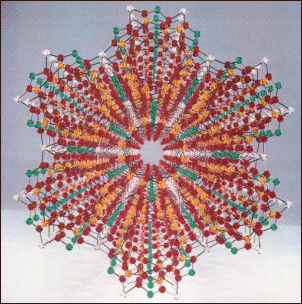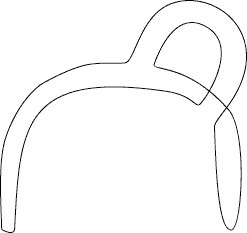Using knitting as a way of exploring mathematical and physical relationships is not a new concept. Crum Brown, a nineteenth century mathematician, knitter and Professor of Chemistry at Edinburgh University, believed passionately in the value of model making as “helps to the imagination.” As a child, models and inventions fascinated him, and he held a life-long interest in knots, and three-dimensional knitting. A mathematician of great imagination and ingenuity, rumor has it that he sat up in bed every night, knitting. He used whatever was at hand to describe the complex relationships of plane geometry, or chemical structure, constructing models of all sorts, many of which survive, both at the Science Museum of London, and the Beevers Miniature Models Unit at Edinburgh University.
 One remarkable exhibit is a model defining the structure of rock salt. Using nothing but of balls of wool held together with knitting needles, Brown correctly illustrated the precise arrangement of ions in the crystalline structure long before X-Ray diffraction proved him right. It is, however, his knitted examples of interlaced planes that remain the most fascinating, and perhaps the most mysterious examples of how his mind worked. In one example, a simple, unprepossessing looking knitted tube, of about eight inches in length, was worked in a pentagram pattern, in alternating shades of red, green and cream-colored aran weight yarn. Looking down inside the tube one can see that the piece is actually constructed of three separate tubes, each knit from a single color, which interlace with one another. No one quite knows how the models were constructed, as the interlaced planes of his seamless knitting were apparently created using a single pair of wooden needles.
One remarkable exhibit is a model defining the structure of rock salt. Using nothing but of balls of wool held together with knitting needles, Brown correctly illustrated the precise arrangement of ions in the crystalline structure long before X-Ray diffraction proved him right. It is, however, his knitted examples of interlaced planes that remain the most fascinating, and perhaps the most mysterious examples of how his mind worked. In one example, a simple, unprepossessing looking knitted tube, of about eight inches in length, was worked in a pentagram pattern, in alternating shades of red, green and cream-colored aran weight yarn. Looking down inside the tube one can see that the piece is actually constructed of three separate tubes, each knit from a single color, which interlace with one another. No one quite knows how the models were constructed, as the interlaced planes of his seamless knitting were apparently created using a single pair of wooden needles.
A similar fascination with planes and surfaces led Cliff Stole, California mathematician, physicist, astronomer, and best selling author, to a Berkeley yarn shop. A man whose enthusiasm for his subject makes it seem as though he speaks in exclamation marks, Cliff was searching for tools he could use to describe the complex world of topology, or the study of surfaces. Although he’d never knit in his life, he wanted to create a quirky little vessel known a Klein Bottle.
 This impossible object, which technically only exists in the fourth dimension, has no inside, no outside, and no edges. It is a “zero volume container” which is to say that it’s not capable of holding liquid. At least not in the third dimension, which is the one we happen to occupy. How is it possible to create such an object? Cliff explains, “Think about a photograph. A photo is a two-dimensional representation of something in three-dimensional space. The photo shows height and width – two dimensions – but not depth. A Klein Bottle is just like a photo, except that it is a three-dimensional representation of something which exists in four-dimensional space.”
This impossible object, which technically only exists in the fourth dimension, has no inside, no outside, and no edges. It is a “zero volume container” which is to say that it’s not capable of holding liquid. At least not in the third dimension, which is the one we happen to occupy. How is it possible to create such an object? Cliff explains, “Think about a photograph. A photo is a two-dimensional representation of something in three-dimensional space. The photo shows height and width – two dimensions – but not depth. A Klein Bottle is just like a photo, except that it is a three-dimensional representation of something which exists in four-dimensional space.”
Cliff had been making and selling blown glass Klein Bottles, under his own Acme label, over the Internet for several years. He wanted, however, to explore other ways of producing the object. He hit upon the idea of Klein Bottle Hats that, in our three dimensional universe, seemed like they would do a good job of keeping ears warm, and doggedly set out to produce a prototype. He began with a bag full of old sweaters from a local thrift shop, cutting and sewing in a largely futile effort to create the shape he wanted. Realizing that hand knitting the hats would be a far easier way of producing them, he set out for the local yarn shop, where the friendly proprietor soon taught him the basics of knitting and purling, increasing and decreasing.
By his own admission, Cliff, however, is the world’s worst knitter. “I keep a basket for dropped stitches beside me while I knit,” he says, tongue in cheek. “And it’s always full.” Determined to solve the problems born of his unfamiliarity with the way knit fabric behaves, he approached Bay Area knitters, Betty Lampen and Eleanor Kent. Between them they quickly created a workable pattern, and the world’s first zero-volume hat was born.
 Finding a way to manufacture the hats became the next obstacle to overcome, as commercial knitwear companies were simply unable to produce the oddly shaped hat. Cliff’s sample hat traveled all over the world, eventually bringing home the realization that the hats could not be mass-produced. In the end, Cliff settled on a team of hand-knitters on the east coast, who now produce his “zero volume hats, for zero volume heads” using Brown Sheep Yarn. The collection has even been expanded to include another topological favorite, matching Moebius Strip scarves.
Finding a way to manufacture the hats became the next obstacle to overcome, as commercial knitwear companies were simply unable to produce the oddly shaped hat. Cliff’s sample hat traveled all over the world, eventually bringing home the realization that the hats could not be mass-produced. In the end, Cliff settled on a team of hand-knitters on the east coast, who now produce his “zero volume hats, for zero volume heads” using Brown Sheep Yarn. The collection has even been expanded to include another topological favorite, matching Moebius Strip scarves.
In the process of sorting out the manufacturing, Cliff eventually learned what many knitters already know: there isn’t a lot of profit in manufacturing hand-knit garments. For Cliff, however, “It never was about money.” With fervor familiar to both scientists and knitters everywhere, Cliff explained his motivation for creating the Klein Bottle Hat: “Once I got the idea, I couldn’t let it go,” he said.
With insight born, no doubt, from his years in the sciences, Cliff has realized that knitters might be eager to create their very own Klein Bottle Hats. With that in mind, he has thoughtfully provided instructions. Proof, if such is needed, that mathematicians are not without humor.

Additional Resources:
Klein Bottle Hat pattern by Nathanael Berglund (PDF)
Math4 Knitters Podcast – with Lara Neel
No Pattern Knits, by Pat Ashford – Leave patterns aside and make beautiful clothing and accessories from simple geometric shapes. (UK)
Making Mathematics with Needlework, by Sarah-Marie Belcastro and Carolyn Yackel – A beautiful marriage of math and fiberarts, the book features ten mathematical papers, and ten stunning patterns illustrating the concepts. (UK)
Mathematical Knitting– For more math and needlework links check out Sarah-Marie Belcastro’s excellent website.

Supercool! The geek in me can’t decide which to knit first, the DNA scarf or the Klein hat! 🙂
I read this, and knew I had seen it before, so I looked at my small stash of treasured Interweave Knits magazines that have survived numerous attempts to purge my books and magazines. They all have one thing in common, an article by Brenda Dayne. Amazing! (I’ve never made the connection before now).
Thank you!! Thank you for your fine work!
Ah: The art/science model at work. And warm, too. Perfect.
What a fascinating article! Keep up the good work! All your writing skills that you learned at Saint Mary’s Academy High School in Portland, Oregon certainly show in this piece. Now aren’t you sorry you didn’t study even harder? But I must admit your writing skills are so good I honestly don’t know how you do it. Since you and your three sisters are so darn talented, and so is your mother, I shouldn’t be surprised.
For those of you from around the world, Oregon USA is the state just above California on the west Coast.
(pronounced Ory-gun, if you say Or-e-gone, we kick you out of the state and send you to California).
What about knitting fractals? A nice piece of Mandelbrot perhaps?
Knitting + Science = Joy! Thank you for taking the time to share these creative and innovative ideas with us.
P.S. Love the new website design. As they say in Japan (where I’m currently living), “O tsukare sama deshita” (thank you for your work).
Wow – and funny as I found a cable called “Watson and Crick” in the Vogue Cable book and was planning on making a bib with it for my soon to be baby. However, now that I’ve seen this totally wonderful cable I think I’m going to have to modify it and use this. Or maybe both.
Ah, science and art. Isn’t it fun?
Is Cast On still being produced?
It’s been a wonderful, absolutely wonderful podcast.